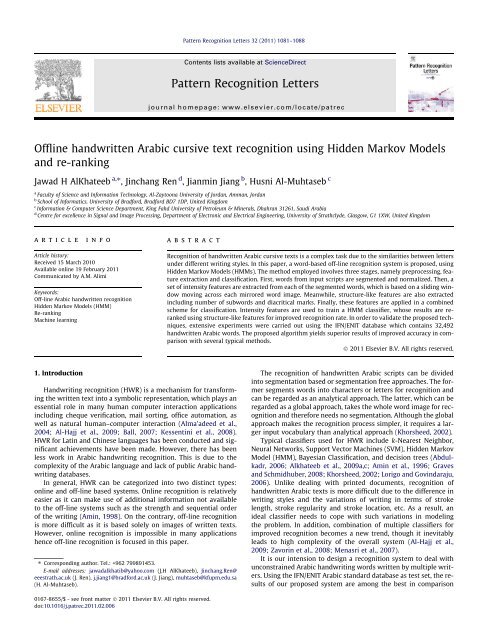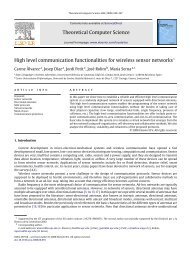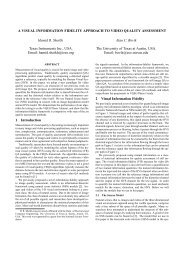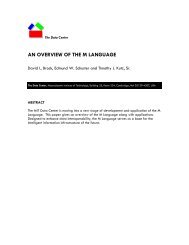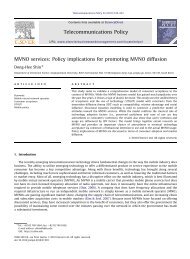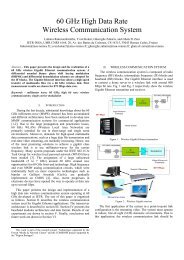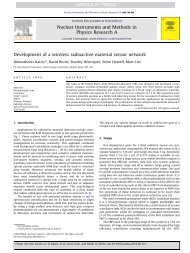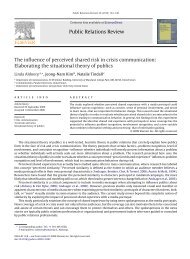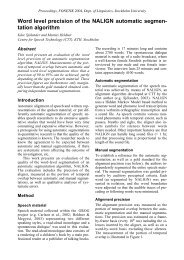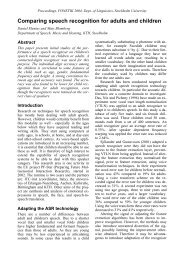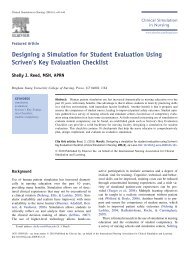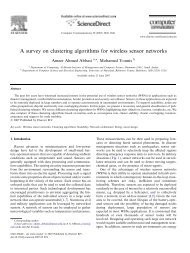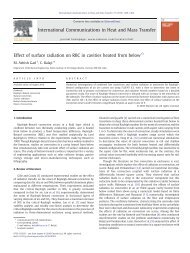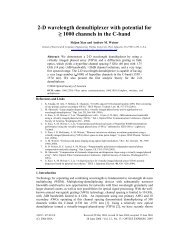Offline handwritten Arabic cursive text recognition using Hidden ...
Offline handwritten Arabic cursive text recognition using Hidden ...
Offline handwritten Arabic cursive text recognition using Hidden ...
You also want an ePaper? Increase the reach of your titles
YUMPU automatically turns print PDFs into web optimized ePapers that Google loves.
<strong>Offline</strong> <strong>handwritten</strong> <strong>Arabic</strong> <strong>cursive</strong> <strong>text</strong> <strong>recognition</strong> <strong>using</strong> <strong>Hidden</strong> Markov Models<br />
and re-ranking<br />
Jawad H AlKhateeb a,⇑ , Jinchang Ren d , Jianmin Jiang b , Husni Al-Muhtaseb c<br />
a Faculty of Science and Information Technology, Al-Zaytoona University of Jordan, Amman, Jordan<br />
b School of Informatics, University of Bradford, Bradford BD7 1DP, United Kingdom<br />
c Information & Computer Science Department, King Fahd University of Petroleum & Minerals, Dhahran 31261, Saudi Arabia<br />
d Centre for excellence in Signal and Image Processing, Department of Electronic and Electrical Engineering, University of Strathclyde, Glasgow, G1 1XW, United Kingdom<br />
article info<br />
Article history:<br />
Received 15 March 2010<br />
Available online 19 February 2011<br />
Communicated by A.M. Alimi<br />
Keywords:<br />
Off-line <strong>Arabic</strong> <strong>handwritten</strong> <strong>recognition</strong><br />
<strong>Hidden</strong> Markov Models (HMM)<br />
Re-ranking<br />
Machine learning<br />
1. Introduction<br />
abstract<br />
Handwriting <strong>recognition</strong> (HWR) is a mechanism for transforming<br />
the written <strong>text</strong> into a symbolic representation, which plays an<br />
essential role in many human computer interaction applications<br />
including cheque verification, mail sorting, office automation, as<br />
well as natural human–computer interaction (Alma’adeed et al.,<br />
2004; Al-Hajj et al., 2009; Ball, 2007; Kessentini et al., 2008).<br />
HWR for Latin and Chinese languages has been conducted and significant<br />
achievements have been made. However, there has been<br />
less work in <strong>Arabic</strong> handwriting <strong>recognition</strong>. This is due to the<br />
complexity of the <strong>Arabic</strong> language and lack of public <strong>Arabic</strong> handwriting<br />
databases.<br />
In general, HWR can be categorized into two distinct types:<br />
online and off-line based systems. Online <strong>recognition</strong> is relatively<br />
easier as it can make use of additional information not available<br />
to the off-line systems such as the strength and sequential order<br />
of the writing (Amin, 1998). On the contrary, off-line <strong>recognition</strong><br />
is more difficult as it is based solely on images of written <strong>text</strong>s.<br />
However, online <strong>recognition</strong> is impossible in many applications<br />
hence off-line <strong>recognition</strong> is focused in this paper.<br />
⇑ Corresponding author. Tel.: +962 799891453.<br />
E-mail addresses: jawadalkhatib@yahoo.com (J.H AlKhateeb), Jinchang.Ren@<br />
eeestrath.ac.uk (J. Ren), j.jiang1@bradford.ac.uk (J. Jiang), muhtaseb@kfupm.edu.sa<br />
(H. Al-Muhtaseb).<br />
0167-8655/$ - see front matter Ó 2011 Elsevier B.V. All rights reserved.<br />
doi:10.1016/j.patrec.2011.02.006<br />
Pattern Recognition Letters 32 (2011) 1081–1088<br />
Contents lists available at ScienceDirect<br />
Pattern Recognition Letters<br />
journal homepage: www.elsevier.com/locate/patrec<br />
Recognition of <strong>handwritten</strong> <strong>Arabic</strong> <strong>cursive</strong> <strong>text</strong>s is a complex task due to the similarities between letters<br />
under different writing styles. In this paper, a word-based off-line <strong>recognition</strong> system is proposed, <strong>using</strong><br />
<strong>Hidden</strong> Markov Models (HMMs). The method employed involves three stages, namely preprocessing, feature<br />
extraction and classification. First, words from input scripts are segmented and normalized. Then, a<br />
set of intensity features are extracted from each of the segmented words, which is based on a sliding window<br />
moving across each mirrored word image. Meanwhile, structure-like features are also extracted<br />
including number of subwords and diacritical marks. Finally, these features are applied in a combined<br />
scheme for classification. Intensity features are used to train a HMM classifier, whose results are reranked<br />
<strong>using</strong> structure-like features for improved <strong>recognition</strong> rate. In order to validate the proposed techniques,<br />
extensive experiments were carried out <strong>using</strong> the IFN/ENIT database which contains 32,492<br />
<strong>handwritten</strong> <strong>Arabic</strong> words. The proposed algorithm yields superior results of improved accuracy in comparison<br />
with several typical methods.<br />
Ó 2011 Elsevier B.V. All rights reserved.<br />
The <strong>recognition</strong> of <strong>handwritten</strong> <strong>Arabic</strong> scripts can be divided<br />
into segmentation based or segmentation free approaches. The former<br />
segments words into characters or letters for <strong>recognition</strong> and<br />
can be regarded as an analytical approach. The latter, which can be<br />
regarded as a global approach, takes the whole word image for <strong>recognition</strong><br />
and therefore needs no segmentation. Although the global<br />
approach makes the <strong>recognition</strong> process simpler, it requires a larger<br />
input vocabulary than analytical approach (Khorsheed, 2002).<br />
Typical classifiers used for HWR include k-Nearest Neighbor,<br />
Neural Networks, Support Vector Machines (SVM), <strong>Hidden</strong> Markov<br />
Model (HMM), Bayesian Classification, and decision trees (Abdulkadr,<br />
2006; Alkhateeb et al., 2009a,c; Amin et al., 1996; Graves<br />
and Schmidhuber, 2008; Khorsheed, 2002; Lorigo and Govindaraju,<br />
2006). Unlike dealing with printed documents, <strong>recognition</strong> of<br />
<strong>handwritten</strong> <strong>Arabic</strong> <strong>text</strong>s is more difficult due to the difference in<br />
writing styles and the variations of writing in terms of stroke<br />
length, stroke regularity and stroke location, etc. As a result, an<br />
ideal classifier needs to cope with such variations in modeling<br />
the problem. In addition, combination of multiple classifiers for<br />
improved <strong>recognition</strong> becomes a new trend, though it inevitably<br />
leads to high complexity of the overall system (Al-Hajj et al.,<br />
2009; Zavorin et al., 2008; Menasri et al., 2007).<br />
It is our intension to design a <strong>recognition</strong> system to deal with<br />
unconstrained <strong>Arabic</strong> handwriting words written by multiple writers.<br />
Using the IFN/ENIT <strong>Arabic</strong> standard database as test set, the results<br />
of our proposed system are among the best in comparison
1082 J.H AlKhateeb et al. / Pattern Recognition Letters 32 (2011) 1081–1088<br />
with quite a few state-of-art approaches. The main contributions<br />
which cover several key techniques proposed in our system can<br />
be highlighted as follows.<br />
(1) To design efficient pre-processing algorithms for baseline<br />
detection and word segmentation, where statistical analysis<br />
and knowledge-assisted decision making are employed.<br />
(2) With detected baseline, several structural features are<br />
extracted such as subwords, single/double/triple dots below<br />
the baseline and single/double dots above the baseline. From<br />
segmented words, a group of intensity features are extracted<br />
<strong>using</strong> a sliding window applied on mirrored word image.<br />
(3) To apply the above features for word <strong>recognition</strong> <strong>using</strong> a<br />
combined scheme, where intensity features are used to train<br />
a HMM classifier, whose results are further improved via reranking<br />
<strong>using</strong> extracted structural features. The re-ranking<br />
scheme is found to generate much improved results yet<br />
avoids multiple classifiers and additional non-visual features<br />
as used in other systems.<br />
(4) A quantitative measurement is defined to indicate how biased<br />
a test set is distributed, and this is further used for error analysis<br />
when results from different test sets are available.<br />
The remainder of this paper is structured as follows. Section 2<br />
describes the <strong>Arabic</strong> language while Section 3 presents literature<br />
review. Details of our proposed method in terms of pre-processing<br />
and feature extraction as well as classification are discussed in Section<br />
4. Comprehensive results are presented in Section 5, and the<br />
paper ends with conclusions and suggestions for further work in<br />
Section 6.<br />
2. The <strong>Arabic</strong> language<br />
Written by more than 250 million people, <strong>Arabic</strong> is one of the<br />
major worldwide document sources (Amin, 1998). With few similarities<br />
and many differences to written English, by its nature, <strong>Arabic</strong><br />
<strong>text</strong> is <strong>cursive</strong>, which makes its <strong>recognition</strong> more difficult than<br />
that of printed Latin <strong>text</strong>. On the other hand, <strong>Arabic</strong> writing, in a<br />
similar way to English, uses letters. The <strong>Arabic</strong> alphabet consists<br />
of 28 letters, and <strong>text</strong> is written from right to left in a <strong>cursive</strong><br />
way. Each <strong>Arabic</strong> letter has either two or four shapes depending<br />
on its possible position in the <strong>text</strong>, including start, middle, end, or<br />
alone (Amin et al., 1996; Abdulkadr, 2006). For example, the letter<br />
Ayn has the following shapes: start middle , end , and<br />
alone . The details of the letter shapes are illustrated in Table 1,<br />
and obviously this has brought more difficulty for automatic <strong>recognition</strong><br />
of <strong>Arabic</strong> <strong>text</strong>s.<br />
In addition, the <strong>Arabic</strong> language uses diacritical marking such as<br />
fattha, dumma, kasra, hamza(zigzag), shadda, ormadda. Using dots<br />
makes some <strong>Arabic</strong> letters special as follows (Amin, 1998; Lorigo<br />
and Govindaraju, 2006):<br />
Ten <strong>Arabic</strong> letters have one dot .<br />
Three <strong>Arabic</strong> letters have two dots .<br />
Two <strong>Arabic</strong> letters have three dots .<br />
Several <strong>Arabic</strong> letters include loop .<br />
The presence or absence of vowel diacritical indicates different<br />
meanings (Amin, 1998). For example: refers to college or kidney,<br />
and denotes love or seeds, and diacritical marking are<br />
essential to differentiate between possible meanings. However,<br />
the diacritical marking may be ignored in <strong>handwritten</strong> unless the<br />
words are isolated, and this introduces additional difficulty in<br />
our <strong>recognition</strong> task. As removal of any of these dots will lead to<br />
a misinterpretation of the character, efficient pre-processing tech-<br />
niques have to be used in order to deal with these dots without<br />
removing them and changing the identity of the character.<br />
There are six letters which are not connected from the left<br />
resulting in the separation of the word into sub-words or pieces<br />
of <strong>Arabic</strong> words (PAW) (Amin, 2000, Lorigo and Govindaraju,<br />
2006; Amin, 1998). Generally, the <strong>handwritten</strong> <strong>text</strong> is written on<br />
a page divided into lines which are further divided into words.<br />
There are spaces between the lines and the words. The spaces between<br />
the words define the word boundaries. Usually, the space<br />
between the sub-words is one third of the space between the<br />
words. This is done consistently in printed <strong>text</strong>, however, it varies<br />
in <strong>handwritten</strong> <strong>text</strong> and leads to inconsistency in segmentation of<br />
words and subwords (Amin, 2000).<br />
3. Literature review<br />
In (Khorsheed and Clocksin, 1999), words were recognised as a<br />
single unit depending on a predefined lexicon. In Stentiford’s algorithm<br />
(Parker, 1997), skeleton of words were used for word <strong>recognition</strong>,<br />
where structural features were extracted for <strong>recognition</strong> in<br />
three consecutive steps, including segment extraction, loop extraction<br />
and segment transformation. Using vector quantization (VQ),<br />
each feature vector was mapped to the nearest symbol in the codebook<br />
resulting in a sequence of observation to be fed into HMM. The<br />
technique was tested with a lexicon of 294 words acquired from different<br />
<strong>text</strong> sources, and a <strong>recognition</strong> rate of up to 97% was achieved.<br />
Khorsheed (Khorsheed, 2003) presented another holistic <strong>recognition</strong><br />
system for recognizing <strong>Arabic</strong> <strong>handwritten</strong> words, where<br />
structural features for the <strong>handwritten</strong> script were extracted after<br />
decomposing the word skeleton into a sequence of links with an<br />
order similar to the writing order. Using the line approximation<br />
(Parker, 1997), each line was broken into small line segments,<br />
which were transferred into a sequence of discrete symbols <strong>using</strong><br />
VQ. Then an HMM recognizer was applied with image skeletonization<br />
to the <strong>recognition</strong> of an old <strong>Arabic</strong> manuscript (Khorsheed,<br />
2000). The HMM was performed <strong>using</strong> 296 states on 32 character<br />
models, and each model was left to right HMM with no restriction<br />
jump margin. The system was tested on 12,960 <strong>recognition</strong> tests<br />
associated with 405 character samples of a single font extracted<br />
from single manuscript. The <strong>recognition</strong> rates achieved was 87%<br />
with spelling check and 72% if not.<br />
Pechwitz and Maergner (2003) presented an off-line system for<br />
the <strong>recognition</strong> of isolated <strong>Arabic</strong> <strong>handwritten</strong> words, where the<br />
IFN/ENIT dataset version v1.0p2 (Pechwitz et al., 2002), containing<br />
four sets (a–d), was used to valid their system. Pixel values from<br />
sliding windows were used as main features, along with Karhunen<br />
Loeve Transformation (KLT) for feature dimension reduction. The<br />
first three sets (a–c) were used for training and the remaining<br />
one for testing their Semi Continuous HMMs (SCHMM) classifier,<br />
and a <strong>recognition</strong> rate of 89% was achieved.<br />
SCHMM was also used in (Benouareth et al., 2006, 2008) for offline<br />
unconstrained <strong>handwritten</strong> <strong>Arabic</strong> word <strong>recognition</strong>. Statistical<br />
and structural features were utilized on the basis of the adopted<br />
segmentation in which implicit word segmentation was used to divide<br />
images into vertical frames of constant and variable width for<br />
feature extraction. Based on maxima and minima analysis of the<br />
vertical projection histogram, morphological complexity of <strong>handwritten</strong><br />
characters is further considered. Using the same dataset<br />
and under same experimental conditions, the <strong>recognition</strong> rate<br />
achieved with uniform segmentation was 81.02% for top 1 and<br />
91.74% for top 10. For non-uniform segmentation, the <strong>recognition</strong><br />
rate was 83.79% for top 1 and 92.12% for top 10, respectively.<br />
Similar strategy was also employed in another HMM-based system<br />
(El-Abed and Margner, 2007), where statistical features were<br />
length of skeleton in four directions extracted from five horizontal
Table 1<br />
<strong>Arabic</strong> letter shapes.<br />
zones of equal height. Using the same training and testing conditions<br />
with the IFN/ENIT v1.0p2, the <strong>recognition</strong> rate achieved<br />
was 89.1% for top 1 and 96.4% for top 10 candidates. In (El-Hajj<br />
et al., 2005), HMM was also applied to word <strong>recognition</strong>, <strong>using</strong><br />
24 statistical features like foreground pixel density and concavity<br />
extracted from divided word image along with 15 baseline independent<br />
features. Through modeling each character with a left to<br />
right topology, their HMM classifier had four states for each character<br />
model resulting 159 character models in total. Again <strong>using</strong><br />
the IFN/ENIT database v1.0p2 for training and set d for testing,<br />
their system had a <strong>recognition</strong> rate of 75.41%.<br />
Al-Hajj et al. (2007) presented a two stage system for recognizing<br />
<strong>handwritten</strong> <strong>Arabic</strong> words. In the first stage, three HMM classifiers<br />
were applied with pixel-based features to determine the best<br />
ten candidates (top 10) <strong>using</strong> likelihood. In the second stage, results<br />
from these classifiers were fused for a combined decision<br />
via three schemes, including the sum rule, the majority vote rule,<br />
and neural network based fusion. Using the IFN/ENIT benchmark<br />
database, the <strong>recognition</strong> rate achieved was 90.96%. These three<br />
schemes were also used in (Al-Hajj et al., 2009) to combine three<br />
homogeneous HMM classifiers for improved performance. The <strong>recognition</strong><br />
rate achieved on IFN/ENIT v1.0p2 was 90.26% for top 1,<br />
94.71 for top 2, and 95.68% for top 3.<br />
4. Proposed techniques and system implementation<br />
In this paper, we proposed an off-line <strong>recognition</strong> system for the<br />
<strong>handwritten</strong> <strong>Arabic</strong> <strong>cursive</strong> <strong>using</strong> HMM and re-ranking. The whole<br />
system contains three stages in terms of preprocessing, feature<br />
extraction, and classification in the following sections. The block<br />
diagram of the proposed <strong>handwritten</strong> <strong>Arabic</strong> <strong>cursive</strong> <strong>text</strong> recogni-<br />
J.H AlKhateeb et al. / Pattern Recognition Letters 32 (2011) 1081–1088 1083<br />
Training<br />
samples<br />
Recognized<br />
results<br />
Testing<br />
samples<br />
tion system is shown in Fig. 1. As shown in Fig. 1, once a sample<br />
image is acquired, pre-processing is required to standardize the<br />
signal for better performance in the following stages. Afterwards,<br />
features are extracted and fed to a HMM classifier for classification.<br />
The results of the HMM is further refined by <strong>using</strong> a re-ranking<br />
scheme for improved accuracy. Relevant techniques are discussed<br />
in details as follows.<br />
4.1. Preprocessing<br />
Pre-processing<br />
Reranking<br />
Pre-processing<br />
Feature<br />
Extraction<br />
HMM<br />
classifier<br />
Feature<br />
Extraction<br />
Fig. 1. The proposed scheme for word <strong>recognition</strong>.<br />
Feature<br />
database<br />
The main aim of preprocessing is to enhance the inputted signal<br />
and to represent it in a way which can be measured consistently<br />
for robust <strong>recognition</strong>. Here preprocessing stage involves scanning<br />
the paper document, removing noise, image enhancement, and<br />
segmentation, which are strongly dependent on the quality of<br />
the paper document. As a result, pre-processing includes many relevant<br />
techniques such as thresholding, skew/slant correction, noise
1084 J.H AlKhateeb et al. / Pattern Recognition Letters 32 (2011) 1081–1088<br />
removal, thinning and baseline estimation as well as segmentation<br />
of words, subwords and even characters.<br />
Although separate words have been manually segmented and<br />
binarized in the IFN/ENIT database (Pechwitz et al., 2002), we have<br />
investigated how to generally detect the baseline and also segment<br />
words from scanned <strong>handwritten</strong> <strong>text</strong>s <strong>using</strong> knowledge-based<br />
statistical models. Firstly, we project a given image to the vertical<br />
axis, and calculate the sum of pixels accordingly. The baseline is<br />
then determined as the one of the peak value in the projected signal.<br />
Since the baseline is located below the middle line, only the<br />
peak value in the bottom half part of the projected signal is used<br />
for its detection.<br />
After detection of the baseline, word and subword are segmented<br />
as follows. Firstly, the input image is projected to the horizontal<br />
axis to form a vertical histogram. Then, distances between<br />
each pair of non-zero bins in the histogram are extracted. If this<br />
distance is no less than a threshold dw, it refers to boundary of<br />
two words. Otherwise, if the distance is less than dw but larger than<br />
another smaller threshold ds, it is detected as boundary of subwords.<br />
The two thresholds dw and ds are optimally determined<br />
<strong>using</strong> Bayesian minimum classification error criteria, and further<br />
details can be found in (AlKhateeb et al., 2008, 2009b).<br />
In an ideal handwriting model, the word has to be written in a<br />
horizontal way with both ascenders and descenders aligned along<br />
the vertical direction. However, these conditions are rarely satisfied<br />
in real data. Therefore, normalization is essential to remove<br />
the variation in <strong>handwritten</strong> images for consistent analysis and<br />
measurement. Among many algorithms proposed for this purpose,<br />
the skeletonization technique is one of the most popular and likewise<br />
the normalization algorithm in (Pechwitz and Maergner,<br />
2003) has been employed in this research. A sample image in binary<br />
format is shown in Fig. 2(a), along with its normalized counterpart<br />
in Fig. 2(b).<br />
4.2. Feature extraction<br />
Feature extraction is to remove the redundancy from the data<br />
and gain a more effective representation of the word image by a<br />
set of numerical characteristics, i.e. extracting most essential information<br />
from raw images. According to (Madhvanath and Govindaraju,<br />
2001), features used in off-line <strong>recognition</strong> are classified<br />
into high level features which are extracted from the whole word<br />
image, medium level features which are extracted from the letters,<br />
(a) Original Binary image<br />
(b) Normalized Gray image<br />
(c) Mirror image<br />
and low level features which are extracted from sub-letters. Moreover,<br />
features can also be classified into structural and statistical<br />
ones. Structural features describe the topological and geometrical<br />
characteristics of a pattern, which include strokes, endpoints,<br />
loops, dots and their position related to the baseline. While statistical<br />
features are derived from statistical distribution of pixels and<br />
describing the characteristic measurements of a pattern, which include<br />
zoning, density distribution of pixels that counts the ones<br />
and zeros, moments (Lorigo and Govindaraju, 2006), etc.<br />
To cope with the characteristics that how <strong>Arabic</strong> <strong>text</strong>s are written,<br />
sliding windows/frames technique is widely used from right to<br />
left to extract features for off-line <strong>recognition</strong> (Husni et al., 2008).<br />
In this paper, the sliding window technique used in speech <strong>recognition</strong><br />
(Husni et al., 2008) has been adopted, yet applied to mirrored<br />
word image (MWI) after normalization in size to speed<br />
both training and testing process. For other features like discrete<br />
cosine transform (DCT) coefficients and moment invariants, please<br />
refer to our previous work in (Alkhateeb et al., 2009c,d).<br />
Starting from the first pixel of the word, a sliding window is applied<br />
to the MWI to calculate the number of non-background pixels.<br />
The horizontal sliding window has the same height of the word image,<br />
three pixels in width with one overlapped pixel. When the sliding<br />
window is moving from left to right, as shown in Fig. 3, each MWI<br />
is divided into fifteen uniform strips/frames horizontally. From<br />
these window strips, in total 30 features are extracted as follows.<br />
Firstly, the first fifteen features (F1 F15) are determined as<br />
average intensity of the pixels in each strip, i.e.<br />
Fi ¼ðAverage pixel intensity in the ith vertical areaÞji 2½1; 15Š:<br />
ð1Þ<br />
Then, average of these 15 features is used as the sixteenth feature<br />
F16, which denotes overall mean intensity of the whole word<br />
image.<br />
F16 ¼ X15<br />
,<br />
15: ð2Þ<br />
i¼1<br />
Fi<br />
Afterwards, the mean intensity of each consecutive pair of strips<br />
is extracted as fourteen additional features (F17 F30) as follows:<br />
Fiþ16 ¼ðFi þ Fiþ1Þ=2; i 2½1; 14Š: ð3Þ<br />
In addition, several structure-like features are also extracted<br />
including number of connected regions nr, number of connected<br />
regions (dots) below the baseline nb, and number of connected regions<br />
above the baseline na. These are called structure-like features<br />
as to some degree they represent topological structure of the image.<br />
How to use these features to refine recognized results in a<br />
combined scheme are described in details below.<br />
Fig. 2. A sample original binary image (a), normalized grey image (b), mirror image<br />
(c). Fig. 3. Regions used for feature extraction and sliding window.
4.3. Combined scheme for classification <strong>using</strong> HMM and re-ranking<br />
Using the extracted features above, a combined scheme is proposed<br />
for <strong>recognition</strong>, <strong>using</strong> HMM as basic classifier followed by<br />
structure feature based re-ranking. HMM has great potential for<br />
<strong>handwritten</strong> <strong>recognition</strong> (Gunter and Bunke, 2004), especially in<br />
modeling connected nature of <strong>Arabic</strong> <strong>cursive</strong> script (Khorsheed,<br />
2003; El-Hajj et al., 2005; Pechwitz and Maergner, 2003). Basically,<br />
HMM is a finite set of states (N), each of which is associated with a<br />
probability distribution (Rabiner, 1989). Transitions among the<br />
states are governed by a set of probabilities called transition probabilities.<br />
To design such a HMM classifier, several procedures need<br />
to be followed including (i) deciding number of states and observations,<br />
(ii) choosing HMM topology, (iii) model training <strong>using</strong> selected<br />
samples, and (iv) testing and evaluation.<br />
In this paper, we implement our HMM classifier <strong>using</strong> the HMM<br />
Toolkit (HTK), a public available platform for HMM development<br />
which was first used for speech <strong>recognition</strong> (Young et al., 2001).<br />
The simplest but most widely used Bakis topology is employed in<br />
our HMM. An example of such topology with seven states is illustrated<br />
in Fig. 4, allowing state transitions to the same state, the<br />
next state, and the following states only. Such constraints on state<br />
transition are consistent with feature-based observations, as the<br />
later are sequentially extracted from overlapped windows. As a result,<br />
allowing transition to the next two states is useful to incorporate<br />
with potential mis-alignment in segmenting word.<br />
In the training phase, the model is optimized <strong>using</strong> the training<br />
data through an iterative process. The Baum–Welch algorithm, a<br />
variant of the Expectation Maximization (EM) algorithm, is utilized<br />
to maximize the observation sequence probability P(O|k) of the<br />
chosen model k =(p, A, B) for optimization, where parameters A,<br />
B and p, respectively, denote matrix of transition probabilities, matrix<br />
of emission probabilities, and initial states probabilities. For a<br />
training dataset of L observation sequences V = V1, V2, ..., VL, the<br />
optimization aims to adjust model parameters and maximize the<br />
term P(V | k).<br />
In the testing phase, a modified Viterbi algorithm is used for<br />
<strong>recognition</strong>. Given a optimized HMM k =(A, B, p) and an observation<br />
sequence O = o 1, o 2, ..., o N, the observation (feature vector)<br />
is modeled with a mixture of Gaussian. Then, the Viterbi algorithm<br />
is used which searches for the highest model probability of a word<br />
given the input feature vector P(O|k) as<br />
Q ¼ arg max PðOjkÞ: ð4Þ<br />
In our implemented HMM, the first K candidates of highest<br />
probability are attained and denoted as Q ={q1, q2, ..., qK}.<br />
Meanwhile, their associated probability values are denoted as<br />
{p1, p2, ...,pK} where p1 P p2 P , ..., P pK. Instead of taking q1 as<br />
the best recognized result, all candidates in Q are re-ranked<br />
and re-ordered according to their refined probability values<br />
p0 1 ; p0 2 ; ...; p0 K . As a result, the best recognized result(s) will be<br />
the one(s) of maximum refined probability values<br />
qm ¼ arg max<br />
m P0<br />
m : ð5Þ<br />
Structure-like features are used in our re-ranking scheme as follows.<br />
For an observation O, denote its structure features as<br />
{na, nb, nr}. For one candidate class c in Q, its associated probability<br />
pc is refined as<br />
Fig. 4. A 7 state hidden Markov Model (HMM).<br />
J.H AlKhateeb et al. / Pattern Recognition Letters 32 (2011) 1081–1088 1085<br />
p 0<br />
c ¼ p Y<br />
c Rtðnt; cÞ; ð6Þ<br />
t¼a;b;r<br />
Rtðnt; cÞ ¼exp<br />
nt nt;c<br />
rt;c<br />
!<br />
2<br />
; ð7Þ<br />
where R t is a Gaussian-like function for re-ranking and t is the index<br />
of structure features; parameters nt;c and rt,c, respectively, denote<br />
the mean and standard deviation of R t for class c, which are determined<br />
during the training stage <strong>using</strong> all samples that belong to c.<br />
As seen, R t achieves its maximum value of 1 when we have nt ¼ nt;c.<br />
Otherwise, the value decreases as a penalty to pc.<br />
It is worth noting that the above re-ranking scheme is different<br />
from several existing ones such as AL-HAJJ et al., 2009; Prasad et<br />
al., 2010; Saleem et al., 2009. Actually, in the first two systems<br />
above, re-ranking is achieved via fusion of multiple classifiers, such<br />
as three HMMs in the first one and both a SVM classifier and a<br />
HMM classifier used in the second one. In addition, non-visual<br />
information like language model and even acoustic scores are employed<br />
for re-ranking in the last two systems. Our re-ranking<br />
scheme, on the contrary, relies on neither multiple classifiers nor<br />
additional non-visual features yet it produces much improved results<br />
as reported in Section 5. For some important parameters of<br />
the HMM, such as number of states and codebook size, they are<br />
empirically determined and relevant results are also reported<br />
and compared in the next section.<br />
5. Experimental results<br />
In this section, the performance of our system is evaluated,<br />
<strong>using</strong> the well-known IFN/ENIT database. Several experiments<br />
are conducted and compared with numerous typical systems from<br />
others, under the same settings. Relevant results are presented in<br />
details below.<br />
5.1. IFN/ENIT database<br />
Although some work was conducted in <strong>Arabic</strong> <strong>handwritten</strong><br />
words since three decades ago, generally they had small databases<br />
of their own or the presented results on databases which were<br />
unavailable to the public. In addition, real data from banking or<br />
postal mails are either confidential or inaccessible to common user<br />
groups. For performance evaluation of different approaches, a large<br />
and public available dataset is very essential. It is not until 2002<br />
that such a dataset, the IFN/ENIT database (www.ifnenit.com), became<br />
available free for non commercial research (Pechwitz et al.,<br />
2002).<br />
The IFN/ENIT database contains 946 <strong>handwritten</strong> Tunisian<br />
town/village names and their corresponding postcodes. In version<br />
v1.0p2, the database consists of 26,459 <strong>Arabic</strong> names <strong>handwritten</strong><br />
by 411 different people. These names consist of 115,000 pieces of<br />
<strong>Arabic</strong> words (PAW, or subwords) and about 212,000 characters.<br />
In a newer version v2.0p1e, one additional set e containing 6033<br />
names <strong>handwritten</strong> by 87 writers was added, which makes the<br />
whole set to have 32,492 name samples.<br />
All the <strong>handwritten</strong> forms were scanned with 300dpi and converted<br />
to binary images. Each <strong>handwritten</strong> name comes with a binary<br />
image with relevant ground truth. Each ground truth entry<br />
contains the following information: (i) <strong>text</strong> for the image, (ii) postcode,<br />
(iii) character shape sequence, (iv) locations of up to two<br />
baselines, (v) baseline quality, (vi) quantity of words, (vii) quantity<br />
of PAWs, (viii) quantity of characters, and (ix) writing quality.<br />
For training and testing purposes, the whole IFN/ENIT dataset is<br />
partitioned into four subsets (a–d) in v1.0p2 and five subsets (a–e)<br />
in v2.0p1e, respectively, where normally the test set is unknown,
1086 J.H AlKhateeb et al. / Pattern Recognition Letters 32 (2011) 1081–1088<br />
not used for training, when a system is tested for evaluation. This<br />
enables cross validation to be applied for performance evaluation.<br />
Unlike some systems such as Kessentini et al. (2008) and El-Hajj<br />
et al. (2005) in which only a small part of the database is used,<br />
we apply our approach to the whole dataset for evaluations. Relevant<br />
experiments and results are presented in the next two<br />
subsections.<br />
5.2. Experiments on IFN/ENIT database v2.0p1e<br />
In this group of experiments, four subsets (a–d) are used for<br />
training the HMM and (e) for testing. To determine an optimal<br />
codebook size for HMM, we compare the <strong>recognition</strong> rate under<br />
various codebook sizes and the results are summarized in Table<br />
2. Possible codebook sizes are specified as 8, 16, 32, 64, and 128,<br />
respectively. As seen in Table 2, better <strong>recognition</strong> rate is yielded<br />
by increased codebook size, yet it takes longer time for training<br />
and testing the HMM classifier. In addition, it is found that the system<br />
reaches its saturation while the codebook size becomes 64 and<br />
more. As a result, an optimal codebook size is set as 64 to achieve a<br />
good tradeoff between high <strong>recognition</strong> rate and low time factor.<br />
Furthermore, it is worth noting that our re-ranking scheme helps<br />
to improve the <strong>recognition</strong> rate. In fact, it contributes 0.43–1.34%<br />
to top 1 <strong>recognition</strong> rate and about 0.84–3.23% for top 10. This validates<br />
the effectiveness of such re-ranking scheme for our task.<br />
Similarly, an optimal number of states used in HMM is also<br />
determined empirically. Using possible numbers varying equally<br />
from 10 to 30, the <strong>recognition</strong> rates obtained are listed in Table 3<br />
for comparisons. It has been noted that the <strong>recognition</strong> rate improves<br />
as the number of states increases till the HTK reaches the<br />
maximum possible state for specific feature set. This makes the<br />
training data is independent of the testing data, and hence avoid<br />
over-fitting the classifier to test the data. In our case, as seen in Table<br />
3, the optimal number of states is found as 25. Again, we can<br />
see obvious improvements in terms of <strong>recognition</strong> rate when reranking<br />
scheme is used.<br />
Furthermore, the performance of our system is compared with<br />
six others in ICDAR 2005 <strong>Arabic</strong> handwriting competition (Margner<br />
et al., 2005). Using the same datasets for training and testing, relevant<br />
results are compared in Table 4. Please note that the test<br />
set e is unknown to participants during the competition, and test-<br />
Table 2<br />
HMM Recognition <strong>using</strong> with different codebook size values.<br />
Codebook size Recognition rate (%)<br />
No re-ranking With re-ranking<br />
Top 1 Top 10 Top 1 Top 10<br />
8 80.82 89.21 81.25 90.05<br />
16 81.05 90.75 81.82 92.87<br />
32 81.92 91.44 82.74 94.09<br />
64 82.32 91.97 83.55 95.08<br />
128 82.32 92.01 83.66 95.24<br />
Table 3<br />
HMM Recognition rate <strong>using</strong> with different number of states.<br />
Number of state Recognition rate (%)<br />
No re-ranking With re-ranking<br />
Top 1 Top 10 Top 1 Top 10<br />
10 79.63 86.32 80.16 89.63<br />
15 80.25 88.15 81.22 91.70<br />
20 81.87 90.43 82.69 93.67<br />
25 82.32 91.97 83.55 95.08<br />
30 82.56 92.26 83.68 95.22<br />
ing results are produced <strong>using</strong> systems submitted to the organizer.<br />
Also note that the results from #5 system is incomplete, as it only<br />
tested on a subset due to data failure. Details about the competition<br />
and techniques used in each participated team can be found<br />
in (Margner et al., 2005). As seen from Table 4, the top 1 <strong>recognition</strong><br />
rate of our proposed approach is 83.55% if re-ranking is used,<br />
or 82.32% if not. On the contrary, the best result from others has a<br />
top-1 <strong>recognition</strong> rate of 75.93%. This shows that our system outperforms<br />
others over 7.6% (or 6.4% without re-ranking) in terms<br />
of top 1 <strong>recognition</strong> rate.<br />
5.3. Experiments on IFN/ENIT database v1.0p2<br />
As discussed in Section 3, four-subset version of IFN/ENIT database<br />
has also been widely adopted in many systems. To enable<br />
consistent performance evaluation, we apply our system on this<br />
version of datasets and compare the results in Table 5. As seen in<br />
Table 5, in total 20 groups of results from nine systems are listed<br />
for comparisons. From Table 5, several observations can be made<br />
and summarized as follows.<br />
When a single HMM classifier is used, the best top 1 <strong>recognition</strong><br />
rate is achieved at 89.74% by Pechwitz and Maergner (2003) when<br />
baseline information from the ground truth is used. The<br />
<strong>recognition</strong> rate is degraded to 83.56% or 81.84% when baseline<br />
is estimated <strong>using</strong> skeleton or projection based techniques, respectively.<br />
Our system with re-ranking produces the second best top-1<br />
<strong>recognition</strong> rate at 89.24%, though this reduces to 86.73% if such<br />
re-ranking is absent. The work in (El-Abed and Margner, 2007)<br />
generates almost the same good results as ours with a top-1 <strong>recognition</strong><br />
rate of 89.10%. However, its top 10 <strong>recognition</strong> rate at 96.4%<br />
is the highest among all others. In contrast, the top 10 <strong>recognition</strong><br />
rates from our system and (Pechwitz and Maergner, 2003) are<br />
95.15% and 94.98%, respectively.<br />
For multi-classifier cases, the work in (Dreuw et al., 2008) is<br />
the best with a top-1 <strong>recognition</strong> rate of 92.86%. This is due to<br />
two main techniques namely character model length adaptation<br />
(MLA) and support of additional virtual training samples (MVT)<br />
on the base of their interesting white-space models, where HMMs<br />
of different topologies are applied in character and white-space<br />
models. Using a hybrid HMM/NN classifier, HMM is used to represent<br />
each letter-body, whilst NN is employed to compute the<br />
observations probability distribution (Menasri et al., 2007). When<br />
three different letter models are used, the best <strong>recognition</strong> rate<br />
achieved is 87.4% for top 1 and 96.9% for top 10. Although (Al-<br />
Hajj et al., 2009) yields slightly worse <strong>recognition</strong> rates <strong>using</strong> single<br />
HMM, 87.60% for top 1 and 93.76% for top 10, improved results<br />
are produced <strong>using</strong> their combined approach through<br />
fusion of three HMMs. Under three combination strategies including<br />
sum, majority vote and multi-layer perception (MLP), the top<br />
1 <strong>recognition</strong> rate achieved are 90.61%, 90.26% and 90.96%,<br />
respectively. Accordingly, the top 10 <strong>recognition</strong> rates are<br />
95.87%, 95.68% and 94.44%. This on one hand shows that combined<br />
classifier indeed produces much improved top 1 classification<br />
rate. On the other hand, it seems that such combination does<br />
not necessarily ensure a high top 10 rate. One possible reason is<br />
that top 1 rate is the first priority when a combined strategy is<br />
designed. In addition, the best results from (Dreuw et al., 2008)<br />
suggest that modeling of characters has great potential in correctly<br />
recognizing words.<br />
Furthermore, it is worth noting that the results from our approach<br />
with re-ranking are among the best in Table 5, although<br />
ground truth information like baseline location and fusion of multiple<br />
classifiers are not used. Thanks to the re-ranking scheme, it<br />
has successfully improved the <strong>recognition</strong> rate yet avoided bringing<br />
much additional complexity to the algorithm.
Table 4<br />
Top 1 <strong>recognition</strong> rate of ICDAR 2005 systems vs. our system<strong>using</strong> IFN/ENIT database v2.0p1e.<br />
System ID #1 #2 #3 #4 #5 #6 Our system<br />
No re-ranking With re-ranking<br />
Recognition rate 65.74 35.7 29.62 75.93 15.36 74.69 82.32 83.55<br />
Table 5<br />
Performance of <strong>recognition</strong> from various HMM-based systems <strong>using</strong> IFN/ENIT database v1.0p2.<br />
5.4. Error analysis<br />
Like all other systems, the proposed approach also has a certain<br />
level of error rate. Actually, our system with re-ranking has an error<br />
rate of 16.45% for tests <strong>using</strong> version v2.0p1e of the database,<br />
and this reduces to 10.76% if version v1.0p2 of the database is used.<br />
In fact, the main reasons for these errors can be summarized as<br />
follows.<br />
The first is inconsistency within the captured <strong>handwritten</strong> samples,<br />
which includes not only variations in shape and size, but also<br />
presence or absence of diacritical marks. As discussed in Section 2,<br />
diacritical marks are essential in distinguishing ambiguity between<br />
words, yet they can be skipped or put in various forms in <strong>handwritten</strong>.<br />
If one word contains samples in various writing styles/forms<br />
or different words share one similar shape, it inevitably leads to<br />
misclassification. Consequently, spelling check might be useful to<br />
solve this problem for improved accuracy (Khorsheed, 2003).<br />
The second is unbalanced occurrence of samples in the database,<br />
as this number varies from 3 to 381 (EL-HAJJ et al 2005).<br />
When one word has very limited samples, dividing them into different<br />
subsets affects its correct <strong>recognition</strong>, especially when the<br />
sample in test set appears differently from the one (or even absent)<br />
in the training sets. Taking the database of version v2.0p1e for<br />
example, Fig. 5 plots frequency vs. number of PAWs from both<br />
the training and test sets. As seen, there is apparent inconsistency<br />
between training and testing sets, which may lead to inaccurate<br />
modelling and low <strong>recognition</strong> rate. In addition, insufficient samples<br />
also lead to unreliable estimate of the re-ranking function,<br />
as both the mean and standard deviation for re-ranking cannot<br />
be accurately determined. Basically, more biased the samples are<br />
distributed in the test set against the whole database, more likely<br />
a higher error rate is generated. As shown in Table 6, the number of<br />
words for testing contained in test set (d) in database version<br />
v1.0p2 and test (e) in v2.0p1e are quite similar, i.e. 6735 vs.<br />
J.H AlKhateeb et al. / Pattern Recognition Letters 32 (2011) 1081–1088 1087<br />
Fig. 5. Difference of PAW frequency in training and test sets for ICDAR’05<br />
competition.<br />
Table 6<br />
Statistics of IFN/ENIT datasets in our tests.<br />
V1.0p2 V2.0p1e<br />
Whole set Test set (d) Whole set Test set (e)<br />
Number of words 26,459 6735 32,492 6033<br />
Number of writers 411 104 >1000 87<br />
6033. However, the degree of their biased distributions, as defined<br />
in (8), is different.<br />
g ¼ uw=ut; ð8Þ<br />
where g is the biased degree, u w and u t, respectively, refer to number<br />
of writers in the whole set and the test set. In our cases, the<br />
biased degrees for database versions v1.0p2 and v2.0p1e are determined<br />
as 3.95 and 11.49. Obviously, the distribution of test set in<br />
v2.0p1e is more biased. This further explains why tests <strong>using</strong> database<br />
of version v1.0p2 yield higher <strong>recognition</strong> rate than those<br />
<strong>using</strong> version v2.0p1e.
1088 J.H AlKhateeb et al. / Pattern Recognition Letters 32 (2011) 1081–1088<br />
The third is potential errors in pre-processing in terms baseline<br />
detection and word segmentation, as such errors will be propagated<br />
and lead to inexact feature extraction due to wrong word<br />
boundary and/or inaccurate extraction of topological features. Certainly<br />
<strong>using</strong> some information provided by the ground truth, such<br />
as baseline location, can improve the overall performance (Pechwitz<br />
and Maergner, 2003). However, in our system such information<br />
is not employed, as we aim to develop a generic system<br />
where ground truth is unavailable.<br />
6. Conclusions<br />
We have proposed a combined scheme for <strong>Arabic</strong> <strong>handwritten</strong><br />
word <strong>recognition</strong>, <strong>using</strong> a HMM classifier followed by re-ranking.<br />
Basically, intensity features are used to train the HMM, and topological<br />
features are used for re-ranking for improved accuracy.<br />
Using the IFN/ENIT database, the performance of our proposed<br />
method is compared with quite a few state-of-art techniques,<br />
including those in ICDAR 2005 competition and several recently<br />
published ones. Although the best results are generated by <strong>using</strong><br />
fusion of multiple HMMs, the results of our proposed approach<br />
are among the best when a single HMM classifier is used. However,<br />
ground truth information like baseline location is not employed in<br />
our system, which enables it to be applied for more generic applications.<br />
In addition, it is worth noting that with slightly adaptation<br />
the proposed techniques can be applied to other pattern <strong>recognition</strong><br />
tasks. Further investigations include more accurate pro-processing<br />
such as subword segmentation and dots detection for<br />
more effective re-ranking as well as to apply other classifiers like<br />
dynamic Bayesian networks (DBN).<br />
References<br />
Abdulkadr, A., 2006. Two-tier approach for <strong>Arabic</strong> offline handwriting <strong>recognition</strong>.<br />
In: Proc. 10th Internet. Workshop on Frontiers in Handwriting Recognition<br />
(IWFHR), pp. 161–166.<br />
Al-Hajj, M.R., Likforman-Sulem, L., Mokbel, C., 2009. Combining slanted-frame<br />
classifiers for improved HMM-based <strong>Arabic</strong> handwriting <strong>recognition</strong>. IEEE<br />
Trans. Pattern Anal. Machine Intell. 31, 1165–1177.<br />
Al-Hajj, M.R., Mokbel, C., Likforman-Sulem, L., 2007. Combination of HMM-based<br />
classifiers for the <strong>recognition</strong> of <strong>Arabic</strong> <strong>handwritten</strong> words. In: Proc. Ninth<br />
Internet. Conf. Document Analysis and Recognition (ICDAR).<br />
Alkhateeb, J.H., Jiang, J., Ren, J., Khelifi, F., Ipson, S.S., 2009a. Multiclass classification<br />
of unconstrained <strong>handwritten</strong> <strong>Arabic</strong> words <strong>using</strong> machine learning<br />
approaches. Open Signal Process. J. 2 (1), 21–28.<br />
Alkhateeb, J.H., Ren, J., Ipson, S.S., Jiang, J., 2008. Knowledge-based baseline<br />
detection and optimal thresholding for words segmentation in efficient preprocessing<br />
of <strong>handwritten</strong> <strong>Arabic</strong> <strong>text</strong>. In: Proc. Fifth Internet. Conf. Information<br />
Technology: New Generations (ITNG)<br />
Alkhateeb, J.H., Ren, J., Ipson, S.S., Jiang, J., 2009b. Component-based segmentation<br />
of words from <strong>handwritten</strong> <strong>Arabic</strong> <strong>text</strong>. Internet. J. Comput. Systems Sci. Eng. 5<br />
(1).<br />
Alkhateeb, J.H., Ren, J., Jiang, J., Ipson, S.S., 2009c. A machine learning approach for<br />
offline <strong>handwritten</strong> <strong>Arabic</strong> words. Proc. Cyber Worlds.<br />
Alkhateeb, J.H., Ren, J., Jiang, J., Ipson, S.S., 2009d. Unconstrained <strong>Arabic</strong> <strong>handwritten</strong><br />
word feature extraction: A comparative study. In: Proc. Sixth Internet. Conf.<br />
Information Technology: New Generations (ITNG).<br />
Alma’Adeed, S., Higgins, C., Elliman, D., 2004. Off-line <strong>recognition</strong> of <strong>handwritten</strong><br />
<strong>Arabic</strong> words <strong>using</strong> multiple hidden Markov models. Knowl. Based Systems 17,<br />
75–79.<br />
Amin, A., 1998. Off-line <strong>Arabic</strong> character <strong>recognition</strong>: The state of the art. Pattern<br />
Recognition 31, 517–530.<br />
Amin, A., 2000. Recognition of printed arabic <strong>text</strong> based on global features and<br />
decision tree learning techniques. Pattern Recognition 33, 1309–1323.<br />
Amin, A., Al-Sadoun, H., Fischer, S., 1996. Hand-printed <strong>Arabic</strong> character <strong>recognition</strong><br />
system <strong>using</strong> an artificial network. Pattern Recognition 29, 663–675.<br />
Ball, G.R., 2007. <strong>Arabic</strong> Handwriting Recognition <strong>using</strong> Machine Learning<br />
Approaches. Ph.D. Thesis, The Faculty of Graduate School of State University<br />
of New York at Buffalo.<br />
Benouareth, A., Ennaji, A., Sellami, M., 2006. HMMs with explicit state duration<br />
applied to <strong>handwritten</strong> <strong>Arabic</strong> word <strong>recognition</strong>. In: Ennaji, A. (Ed.), 18th<br />
Internet. Conf. Pattern Recognition (ICPR).<br />
Benouareth, A., Ennaji, A., Sellami, M., 2008. Semi-continuous HMMs with explicit<br />
state duration for unconstrained <strong>Arabic</strong> word modeling and <strong>recognition</strong>. Pattern<br />
Recognition Lett. 29, 1742–1752.<br />
Dreuw, P., Jonas, S., Ney, H., 2008. White-space models for offline <strong>Arabic</strong><br />
handwriting <strong>recognition</strong>. In: Proc. 19th Internet. Conf. Pattern Recognition<br />
(ICPR).<br />
El-Hajj, R., Likforman-Sulem, L., Mokbel, C., 2005. <strong>Arabic</strong> handwriting <strong>recognition</strong><br />
<strong>using</strong> baseline dependant features and hidden Markov modeling. In: Proc.<br />
Eighth Internet. Conf. Document Analysis and Recognition (ICDAR).<br />
El-Abed, H., Margner, V., 2007. Comparison of different preprocessing and feature<br />
extraction methods for offline <strong>recognition</strong> of <strong>handwritten</strong> <strong>Arabic</strong> words. In:<br />
Proc. Ninth Internet. Conf. Document Analysis and Recognition (ICDAR’07).<br />
Graves, A., Schmidhuber, J., 2008. <strong>Offline</strong> handwriting <strong>recognition</strong> with<br />
multidimensional recurrent neural networks. In: Proc. 22nd Conf. Neural<br />
Information Processing Systems (NIPS).<br />
Gunter, S., Bunke, H., 2004. HMM-based <strong>handwritten</strong> word <strong>recognition</strong>: On the<br />
optimization of the number of states, training iterations and Gaussian<br />
components. Pattern Recognition 37, 2069–2079.<br />
Husni, A.A.-M., Sabri, A.M., Rami, S.Q., 2008. Recognition of off-line printed <strong>Arabic</strong><br />
<strong>text</strong> <strong>using</strong> <strong>Hidden</strong> Markov Models. Signal Process. 88, 2902–2912.<br />
Kessentini, Y., Paquet, T., Benhamadou, A.M., 2008. Multi-script handwriting<br />
<strong>recognition</strong> with n-streams low level features. In: Proc. 19th Internet. Conf.<br />
Pattern Recognition (ICPR).<br />
Khorsheed, M.S., 2000. Automatic Recognition of Words in <strong>Arabic</strong> Manuscripts.<br />
Computer Laboratory. University of Cambridge.<br />
Khorsheed, M.S., 2002. Off-line arabic character <strong>recognition</strong> – a review. Pattern<br />
Anal. Appl. 5, 31–45.<br />
Khorsheed, M.S., 2003. Recognising <strong>handwritten</strong> <strong>Arabic</strong> manuscripts <strong>using</strong> a single<br />
<strong>Hidden</strong> Markov Model. Pattern Recognition Lett. 24, 2235–2242.<br />
Khorsheed, M.S., Clocksin, W.F., 1999. Structural features of <strong>cursive</strong> <strong>Arabic</strong> script. In:<br />
Proc. 10th British Machine Vision Conf., The University of Nottingham, UK.<br />
Lorigo, L.M., Govindaraju, V., 2006. <strong>Offline</strong> <strong>Arabic</strong> handwriting <strong>recognition</strong>: A<br />
survey. IEEE Trans. Pattern Anal. Machine Intell. 28, 712–724.<br />
Madhvanath, S., Govindaraju, V., 2001. The role of holistic paradigms in<br />
<strong>handwritten</strong> word <strong>recognition</strong>. IEEE Trans. Pattern Anal. Machine Intell. 23,<br />
149–164.<br />
Margner, V., Pechwitz, M., Abed, H.E., 2005. ICDAR 2005 <strong>Arabic</strong> handwriting<br />
<strong>recognition</strong> competition. In: Pechwitz, M. (Ed.), Proc. 8th Internet. Conf.<br />
Document Analysis and Recognition (ICDAR).<br />
Menasri, F., Vincent, N., Augustin, E., Cheriet, M., 2007. Shape-based alphabet for<br />
off-line <strong>Arabic</strong> handwriting <strong>recognition</strong>. In: Proc. 9th Internet. Conf. Document<br />
Analysis and Recognition (ICDAR), vol. 2, pp. 969–973.<br />
Parker, J.R., 1997. Algorithms for Image Processing and Computer Vision. John Wiley<br />
and Sons, Inc..<br />
Pechwitz, M., Maddouri, S.S., Maergner, V., Ellouze, N., Amiri, H., 2002. IFN/ENIT –<br />
database of <strong>Arabic</strong> <strong>handwritten</strong> words. Colloque International Franco-phone sur<br />
l’Ecrit et le Document (CIFED).<br />
Pechwitz, M., Maergner, V., 2003. HMM based approach for <strong>handwritten</strong> <strong>Arabic</strong><br />
word <strong>recognition</strong> <strong>using</strong> the IFN/ENIT – database. In: Maergner, V. (Ed.),<br />
Proceedings Seventh International Conference on Document Analysis and<br />
Recognition.<br />
Prasad, R., Bhardwaj, A., Subramanian, K., Cao, H., Natarajan, P., 2010. Stochastic<br />
segment model adaptation for offline handwriting <strong>recognition</strong>. In: Proc.<br />
Internet. Conf. Pattern Recognition, pp. 1993–1996.<br />
Rabiner, L.R., 1989. A tutorial on hidden Markov models and selected applications in<br />
speech <strong>recognition</strong>. Proc. IEEE 77, 257–286.<br />
Saleem, S., Cao, H., Subramanian, K., Kamali, M., Prasad, R., Natarajan, P., 2009.<br />
Improvements in BBN’s HMM-based offline <strong>Arabic</strong> handwriting <strong>recognition</strong><br />
system. In: Proc. 10th Internet. Conf. Document Analysis and Recognition<br />
(ICDAR).<br />
Young, S., Evermann, G., Kershaw, D., Moore, G., Odeli, J., Ollason, D., Valtchev, V.,<br />
Woodland, P., 2001. The HTK Book. Cambridge University Engineering<br />
Department.<br />
Zavorin, I., Borovikov, E., Davis, E., Borovikov, A., Summers, K., 2008. Combining<br />
different classification approaches to improve off-line <strong>Arabic</strong> <strong>handwritten</strong> word<br />
<strong>recognition</strong>. Proc. of SPIE 6815 (681504).


